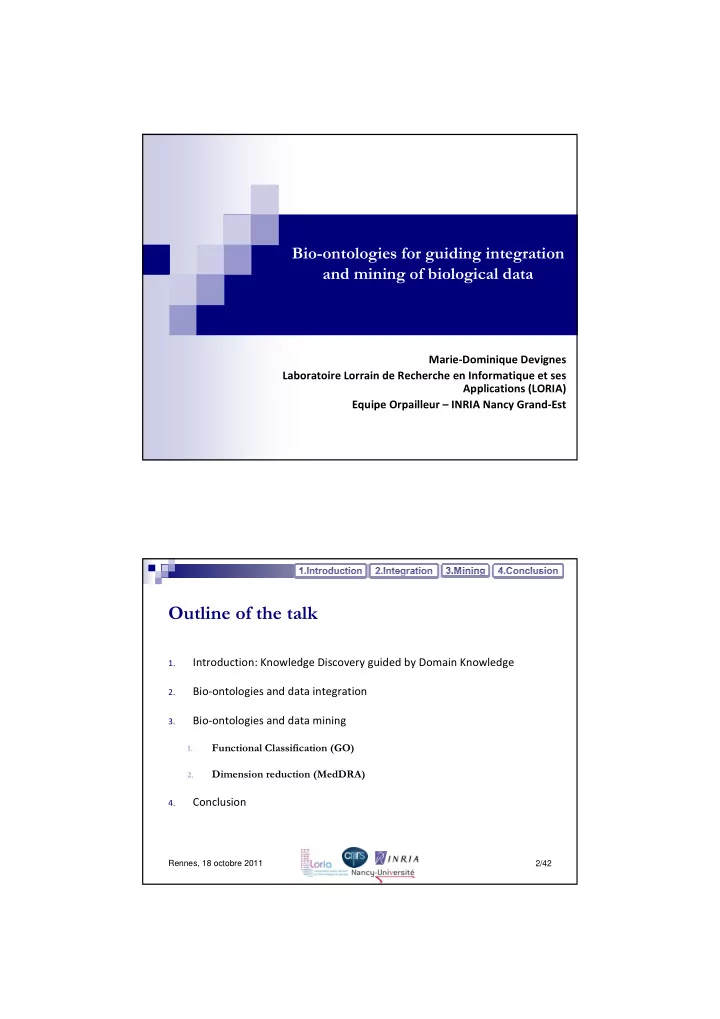

�������������������������� ����������� ���������� ������������� ���� Marie-Dominique Devignes Laboratoire Lorrain de Recherche en Informatique et ses Applications (LORIA) Equipe Orpailleur – INRIA Nancy Grand-Est ������� ����������� Introduction: Knowledge Discovery guided by Domain Knowledge 1. Bio-ontologies and data integration 2. Bio-ontologies and data mining 3. ���������� ������������������� �� ������������������� � ���!"� �� Conclusion 4. Rennes, 18 octobre 2011 2/42
#��$����� �����%��& ���� ��������� �#��� A three-step iterative process… 3. Interpretation 2. Data mining Knowledge 1. Preparation Formatting Rules, patterns Selection Expert Formatted data Integration Dataset Integrated data Database …interactively controlled by an expert. Rennes, 18 octobre 2011 3/42 #��$����� �����%��& ������ �&�������� #��$����� '�#��# Ontologies to assist the expert… 3. Interpretation 2. Data mining Knowledge 1. Preparation Formatting Rules, patterns Selection Expert Formatted data Integration Dataset Integrated data Database … at each step of the process. Rennes, 18 octobre 2011 4/42
(��������)�#��# 3. Result interpretation and KB DB1 enrichment Wrapper 1 DB2 Domain Knowledge 2. Data Wrapper 2 Knowledge Base (KB) Mining Data Wrapper 3 DB3 1. Data extraction and … Etc. formatting Data integration: guided by Data mining : guided by domain knowledge domain knowledge Rennes, 18 octobre 2011 5/42 *��� �� ��#��$����� �����+ � For biologists « knowledge bases » are rich, integrated databases � ,-'�.��)���/�#���/�� 0 /�0 "�,/�1�����#�/����� � #��$����� �� �������� �������������������� � #��$����� �� �������� �&�)�������� ������������� � For computer scientists « knowledge bases » are systems where data are associated with explicit semantics (logic formulas) that can be used by programs � ,-�'����������� ���������)�����2������������� ������/�3����2�4�������/� �556� � #�$����� ���������������������/��������� ������������������������ � Concepts and relations are organized as consistent hierarchies from most general to most specialized � Reasoners are able to classify instances with respect to the concepts they instantiate. Rennes, 18 octobre 2011 6/42
,-��)��� �������2����(������� � A « DL » knowledge base : SO-Pharm ( Adrien Coulet ) � 0���������� )�������������� ��������������� � "�������� ��������� ������ ������ � Structured vocabularies � ������������& � (������� ��������������� � � Semantic similarity measure � Use for functional classification of genes � ���!" '� ������ ���������& ����!��������& "���%����� � ,�������� ������ � � Use for dimension reduction in symbolic mining methods. Rennes, 18 octobre 2011 7/42 ������� ����������� Introduction: Knowledge Discovery guided by Domain Knowledge 1. Bio-ontologies and data integration 2. ,-��)�� ������2����$����� �����'�(��14"! Bio-ontologies and data mining 3. ���������� ������������������� �� ������������������� � ���!"� �� Conclusion 4. Rennes, 18 octobre 2011 8/42
����������������������������������� DB1 � A challenge for many years � ,-'�3" �0(�����778� Wrapper 1 ����)'99$$$�������������9 :���%����9������9 � Domain DB2 � ,-'����$�������� ����557� Knowledge Wrapper 2 ����)'99���$���������������� ���91�����4�����%��%��$ ����� � Data Wrapper 3 � "������& ����; DB3 … Etc. � Not so many examples of « true » knowledge bases Data integration = 1st step of KDDK Rennes, 18 octobre 2011 9/42 �2��������)�����2�������#��$����� ���� � Description Logics (DL) foundations � �����& ������������ ������ � ���� �������������������������� ������������������������������� ��������������� ������� � � ��� ��� ����������������������� ����������������������� �������� �������� ������� ������� � �����)�����������������!���� ������������)� ���$��� �������/������� ������������� � � <������ �&)������������������ �0�����������/�.����/�=�������/�!�����������/������ � In DL, KB = T-Box + A-Box � 3���-�>�3���������& '������)������������ � Atomic concepts (C) or roles (R): simple descriptions � Composed concepts or roles : complex descriptions (terminological axioms) � "���-�>�"�����������������%������9��������� � Concept assertion : C(a) -> instance a belongs to concept C � Role assertion: R(a,b) -> instances a and b are in relation through role R Rennes, 18 octobre 2011 10/42
�2��������)�����2�������#��$����� ���� � Implementation thanks to semantic web technologies � �*2��������� �0���4�������/�1���� ���1�����(�������������������%��� 4�������/��556�� � (1"!?2�'�@���& �������� �����*2����������� � 1���A�A '��������& �������� ����/������ �555� � !����/�1�����/����3 '���������� ����2������������ Rennes, 18 octobre 2011 11/42 "���-��)�� ���)��������������� ��� � Goal of pharmacogenomics � 0������& ����%����� ������ %���������� ������&)�� � ; ���� ������������%������������� �1�����&)��� Drug � ; ������� ��������� ������ � GenNet Project � #0#"�������� B�1�����&����� B�2�!0"�9� ��)������� � Example: SNP variants in geneCYP2D6 (Desmeules et al., 1991) Genotype Phenotype � More or less active forms of a given enzyme � Fast or slow transformation of codein into morphin � Intoxication or absence of reaction to a given treatment Rennes, 18 octobre 2011 12/42
Recommend
More recommend